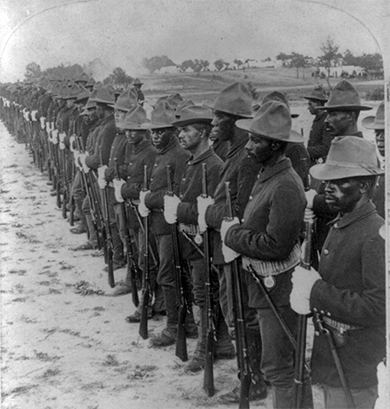| << Chapter < Page | Chapter >> Page > |
To the surprise of the Spanish forces who saw the conflict as a clear war over Cuba, American military strategists prepared for it as a war for empire. More so than simply the liberation of Cuba and the protection of American interests in the Caribbean, military strategists sought to further Mahan’s vision of additional naval bases in the Pacific Ocean, reaching as far as mainland Asia. Such a strategy would also benefit American industrialists who sought to expand their markets into China. Just before leaving his post for volunteer service as a lieutenant colonel in the U.S. cavalry, Assistant Secretary of the Navy Theodore Roosevelt ordered navy ships to attack the Spanish fleet in the Philippines, another island chain under Spanish control. As a result, the first significant military confrontation took place not in Cuba but halfway around the world in the Philippines. Commodore George Dewey led the U.S. Navy in a decisive victory, sinking all of the Spanish ships while taking almost no American losses. Within a month, the U.S. Army landed a force to take the islands from Spain, which it succeeded in doing by mid-August 1899.
The victory in Cuba took a little longer. In June, seventeen thousand American troops landed in Cuba. Although they initially met with little Spanish resistance, by early July, fierce battles ensued near the Spanish stronghold in Santiago. Most famously, Theodore Roosevelt led his Rough Riders , an all-volunteer cavalry unit made up of adventure-seeking college graduates, and veterans and cowboys from the Southwest, in a charge up Kettle Hill, next to San Juan Hill, which resulted in American forces surrounding Santiago. The victories of the Rough Riders are the best known part of the battles, but in fact, several African American regiments, made up of veteran soldiers, were instrumental to their success. The Spanish fleet made a last-ditch effort to escape to the sea but ran into an American naval blockade that resulted in total destruction, with every Spanish vessel sunk. Lacking any naval support, Spain quickly lost control of Puerto Rico as well, offering virtually no resistance to advancing American forces. By the end of July, the fighting had ended and the war was over. Despite its short duration and limited number of casualties—fewer than 350 soldiers died in combat, about 1,600 were wounded, while almost 3,000 men died from disease—the war carried enormous significance for Americans who celebrated the victory as a reconciliation between North and South.
The most popular image of the Spanish-American War is of Theodore Roosevelt and his Rough Riders, charging up San Juan Hill. But less well known is that the Rough Riders struggled mightily in several battles and would have sustained far more serious casualties, if not for the experienced black veterans—over twenty-five hundred of them—who joined them in battle ( [link] ). These soldiers, who had been fighting the Indian wars on the American frontier for many years, were instrumental in the U.S. victory in Cuba.

The choice to serve in the Spanish-American War was not a simple one. Within the black community, many spoke out both for and against involvement in the war. Many black Americans felt that because they were not offered the true rights of citizenship it was not their burden to volunteer for war. Others, in contrast, argued that participation in the war offered an opportunity for black Americans to prove themselves to the rest of the country. While their presence was welcomed by the military which desperately needed experienced soldiers, the black regiments suffered racism and harsh treatment while training in the southern states before shipping off to battle.
Once in Cuba, however, the “Smoked Yankees,” as the Cubans called the black American soldiers, fought side-by-side with Roosevelt’s Rough Riders, providing crucial tactical support to some of the most important battles of the war. After the Battle of San Juan, five black soldiers received the Medal of Honor and twenty-five others were awarded a certificate of merit. One reporter wrote that “if it had not been for the Negro cavalry, the Rough Riders would have been exterminated.” He went on to state that, having grown up in the South, he had never been fond of black people before witnessing the battle. For some of the soldiers, their recognition made the sacrifice worthwhile. Others, however, struggled with American oppression of Cubans and Puerto Ricans, feeling kinship with the black residents of these countries now under American rule.

Notification Switch
Would you like to follow the 'U.s. history' conversation and receive update notifications?